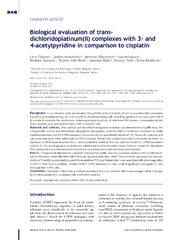Приказ основних података о документу
Biological evaluation of transdichloridoplatinum( II) complexes with 3-and 4-acetylpyridine in comparison to cisplatin
| dc.creator | Filipović, Lana | |
| dc.creator | Aranđelović, Sandra | |
| dc.creator | Gligorijević, Nevenka | |
| dc.creator | Krivokuca, Ana | |
| dc.creator | Jankovic, Radmila | |
| dc.creator | Srdić-Rajić, Tatjana | |
| dc.creator | Rakic, Gordana | |
| dc.creator | Tešić, Živoslav Lj. | |
| dc.creator | Radulović, Siniša | |
| dc.date.accessioned | 2018-11-22T00:24:10Z | |
| dc.date.available | 2018-11-22T00:24:10Z | |
| dc.date.issued | 2013 | |
| dc.identifier.issn | 1318-2099 | |
| dc.identifier.uri | https://cherry.chem.bg.ac.rs/handle/123456789/1414 | |
| dc.description.abstract | Background. In our previous study we reported the synthesis and cytotoxicity of two trans-platinum(II) complexes: trans-[PtCl2(3-acetylpyridine)(2)] (1) and trans-[PtCl2(4-acetylpyridine)(2)] (2), revealing significant cytotoxic potential of 2. In order to evaluate the mechanism underlying biological activity of both trans-Pt(II) isomers, comparative studies versus cisplatin were performed in HeLa, MRC-5 and MS1 cells. Materials and methods. The cytotoxic activity of the investigated complexes was determined using SRB assay. The colagenolytic activity was determined using gelatin zymography, while the effect of platinum complexes on matrix metalloproteinases 2 and 9 mRNA expression was evaluated by quantitative real-time PCR. Apoptotic potential and cell cycle alterations were determined by FACS analyses. Western blot analysis was used to evaluate the effect on expression of DNA-repair enzyme ERCC1, and quantitative real-time PCR was used for the ERCC1 mRNA expression analysis. In vitro antiangiogenic potential was determined by tube formation assay. Platinum content in intracellular DNA and proteins was determined by inductively coupled plasma-optical emission spectrometry. Results. Compound 2 displayed an apparent cytoselective profile, and flow cytometry analysis in HeLa cells indicated that 2 exerted antiproliferative effect through apoptosis induction, while 1 induced both apoptosis and necrosis. Action of 1 and 2, as analyzed by quantitative real-time PCR and Western blot, was associated with down-regulation of ERCC1. Both trans-complexes inhibited MMP-9 mRNA expression in HeLa, while 2 significantly abrogated in vitro tubulogenesis in MS1 cells. Conclusions. The ability of 2 to induce multiple and selective in vitro cytotoxic effects encourages further investigations of trans-platinum(II) complexes with substituted pyridines. | en |
| dc.publisher | Assoc Radiology & Oncology, Ljubljana | |
| dc.relation | info:eu-repo/grantAgreement/MESTD/Integrated and Interdisciplinary Research (IIR or III)/41026/RS// | |
| dc.relation | info:eu-repo/grantAgreement/MESTD/Basic Research (BR or ON)/172017/RS// | |
| dc.rights | openAccess | |
| dc.rights.uri | https://creativecommons.org/licenses/by/4.0/ | |
| dc.source | Radiology and Oncology | |
| dc.subject | angiogenesis | en |
| dc.subject | apoptosis | en |
| dc.subject | MMPs | en |
| dc.subject | MRC-5 | en |
| dc.subject | trans-platinum(II) | en |
| dc.title | Biological evaluation of transdichloridoplatinum( II) complexes with 3-and 4-acetylpyridine in comparison to cisplatin | en |
| dc.type | article | |
| dc.rights.license | BY | |
| dcterms.abstract | Филиповиц, Лана; Срдиц-Рајиц, Татјана; Тешић, Живослав Љ.; Кривокуца, Aна; Радуловиц, Синиса; Ракиц, Гордана; Јанковиц, Радмила; Глигоријевиц, Невенка; Aранделовиц, Сандра; | |
| dc.citation.volume | 47 | |
| dc.citation.issue | 4 | |
| dc.citation.spage | 346 | |
| dc.citation.epage | 357 | |
| dc.identifier.wos | 000325718800005 | |
| dc.identifier.doi | 10.2478/raon-2013-0050 | |
| dc.citation.other | 47(4): 346-357 | |
| dc.citation.rank | M23 | |
| dc.identifier.pmid | 24294179 | |
| dc.type.version | publishedVersion | |
| dc.identifier.scopus | 2-s2.0-84893721152 | |
| dc.identifier.fulltext | https://cherry.chem.bg.ac.rs/bitstream/id/8550/1412.pdf |


